Photo Flash: LAND|SLIDE: Possible Futures, Now Open at Markham Museum
Land|Slide: Possible Futures is a large-scale art intervention featuring 30 local and International Artistsrunning until October 14 at the Markham Museum.
From the creative curatorial team behind The Leona Drive Project and the 2012 Nuit Blanche Museum for the End of the World (City Hall zone) Land|Slide transforms the Markham Museum, including its 30 historic buildings from the 1850s-1930s to create a fascinating backdrop against which artists explore and reinterpret some of the most pressing issues facing Canadians today: how to balance ecology and economy, farming and development, history and diversity.
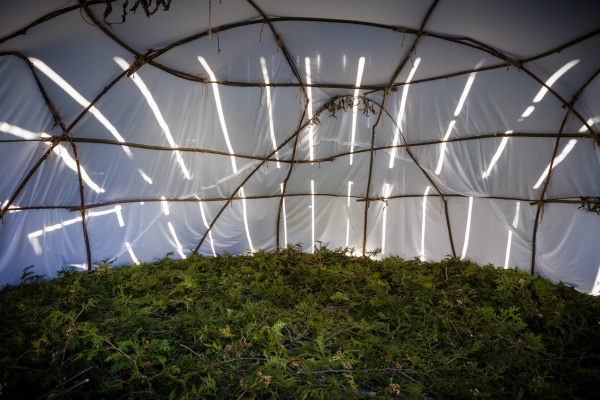
Singing our bones home is a homage to the buried bodies in the Markham Ossuary. This installation utilizes sound, projections and sculpture to create a dialogue between the different architectural structures: the wigwam that represents nomadic lifestyles, and the wagon shed that is a symbol of settlement. The projections convey static or monochromatic landscapes that appear to be dismal or uninhabited. This contrasts with the diverse population currently living in Markham. The installation grapples with the myth of terra nullius, which considers the land to be void of people or settlement.

Always Popular; Never Cool is a full-scale diorama about coercive sex and so called "slut-shaming" Installed in a period-decorated log cabin, it shows six figures playing out a scene that takes place in some liminal space which is both 1857 and the present day: a house party at which a sexual assault has just been interrupted. The figures wear clothes from both the 1850s and today, and music from both eras plays in the background. With this work, we hope to make clear the havoc these incidents wreak for all the people involved, as well as exploring the effects technology has played in the ways in which shame is experienced. By presenting the figures in the installation as citizens of both 2013 and 1857, we hope to show the frightening durability of the ideologies and practices of rape culture.Warning: This installation may contain content only suitable for mature audiences.

Guh Why Low is the Cantonese pronunciation of white ghost, at best a charming nickname or, more likely, a deserved insult that marks whiteness and the empty promise of colonialism. The spectral lesbian haunts the house as the white ghost, traced through lines of European ancestry, simultaneously written and erased through racist and homophobic histories. With same sex marriage (and divorce) well established in Canada, it appears to some as though things are how they ought to be. To others it is a harbinger of doom and the nigh end times. To capture this tension, crocheted cobwebs loom and cloy in corners, knobs rattle, and lesbian ghosts moan from the basement.Warning: This installation may contain content only suitable for mature audiences, and may be frightening to small children.

The Strickler Barn contains four interesting hoist pulleys that express the beauty of primal craftsmanship. Frank Havermans considers these tools as the ultimate form of local intelligence and self-sufficiency. Reincarnated and transformed by a system of pulleys and wheels, the hoist tools use tension to hold up an urban structure outside the barn. The installation is an observation of local intelligence under massive (sub)urban development with the question in mind: Is the city a virus evolved from the same ingenuity that first developed those pulleys, but which in the end destroys rural life?This project is generously supported by the Consulate General of the Kingdom of the Netherlands.Kingdom of the Netherlands.

The MARKHAMAZE will become an important part of world history, (going back over 4000 years,) of pavement designed pathways set into our earth. Throughout history the symbolism of the maze has captured our imaginations & stimulated spiritual consciousness & enlightenment among different cultures worldwide. It's been a desire of the artist IAIN BAXTER& to create an ECOLOGY inspired artwork that will encourage all of us to do our part to save our MOTHER EARTH. Our personal sensitivity to our fragile environment & our continued actions around sustainability will be greatly motivated by visiting & walking the MARKHAMAZE... see YOU there...This project is generously supported by Holcim (Canada) Inc.

Urban Vernacular depicts a series of cobbled-together dwellings located on the fringes of urban space. Plastic bags, obsolete electronics, party decorations the detritus of consumer culture become construction materials, tenuously assembled and decorated by an unseen hand. The forms echo vernacular architectures that might have been built, in the past, from sod or snow, but are instead constructed from today's more plentiful material: trash. Located in urban junkscapes, the assemblages encroach upon existing architectural elements and absorb nearby debris. The scene is set, the story could take place anywhere or nowhere; in the recent past, present, or future. The camera has frozen this one moment, leaving us to speculate as to what has come before or, more importantly, what comes next.

Construction of a 500m river began in June 2013 with cutting sod, tilling and seeding a broken line across the Markham Museum site. By late October, the path will reveal a dynamic and unpredictable growth of over 8 edible flowers primarily sunflowers, a traditional Ontario crop during one of the provinces most turbulent summers.The River will meander, disappear and reappear, to articulate the enduring tension between nature and nurture, past and present, human encroachment and emerging environmental innovation. At its height, The River will act as a beacon to remind the visitor of an agrarian history while providing a visual bridge to Markham's possible future as a unique corridor for sustainable living.
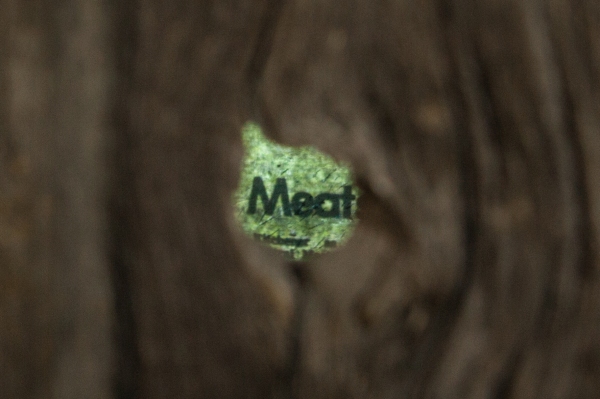
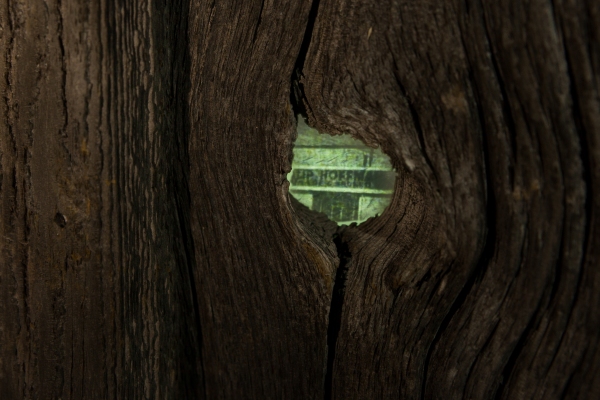
Several manifestations of slaughter are revealed in the slaughterhouse building. The seven-channel work is viewed and heard from the outside of the building though several peek holes in the aged barn boards. Slaughterhouse weaves several inter-connected stories of loss throughout southern Ontario: of land and agriculture, of property and business, through political, social, economic and environmental slaughter. The materials are gleaned from public and personal sources, including the rise and fall of the his family's slaughterhouse and pork processing plant, Hoffman Meats (1951-81), in Kitchener, Ontario. Editing and Sound Design by Marcel Beltran.Slaughterhouse is produced with the support of the Canada Council for the Arts.
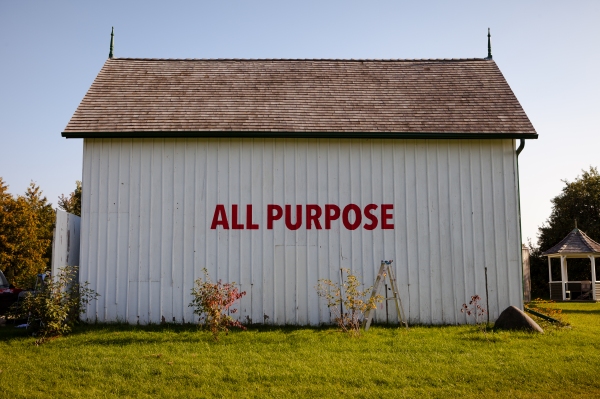
Transformed by the artists, the interior of this heritage structure has been stripped of most local and historic characteristics refined and enriched to meet the generic expectations for mass high art consumption. This aesthetic sets the tone for the collective's concept cafe, featuring minimalist snack offerings made from white ingredients: milk, salt, lard, flour and/or sugar. The project references relational food art practices, but also addresses highly processed and ubiquitous white food commodities, acknowledging the way these ingredients reflect the global food and art markets.The artists will be present for special one-off performances throughout the exhibition.
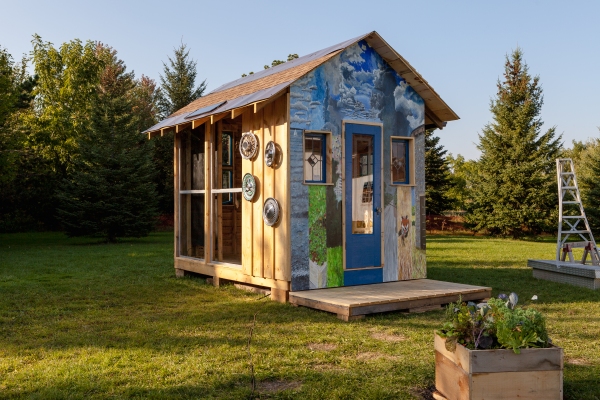
The 8 1/2 x 12 1/2 structure is made for sustainable living, with up of four different walls, each exhibiting a low-tech building technique, as well as off the grid heating, lighting and water collection. These techniques employ papercrete cordwood, cedar cut-off shingling, and board and batten. The building is a demonstration of mixing the creative and the pragmatic, of reclaiming basic skills of construction, where the process itself becomes an important part of the narrative of a home. The project encourages pondering on where the form of our shelter is going, without simply wanting to return to the past. This building represents but one possibility among many.
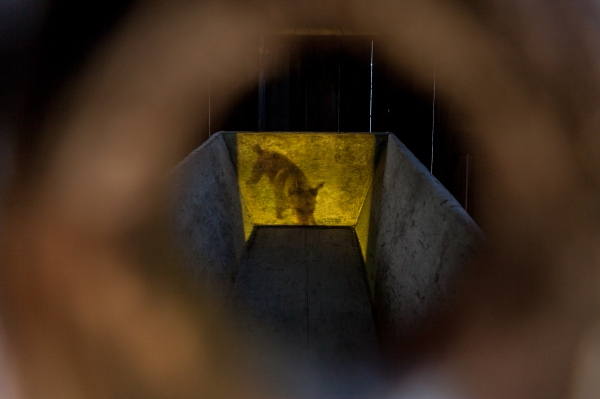
Several manifestations of slaughter are revealed in the slaughterhouse building. The seven-channel work is viewed and heard from the outside of the building though several peek holes in the aged barn boards. Slaughterhouse weaves several inter-connected stories of loss throughout southern Ontario: of land and agriculture, of property and business, through political, social, economic and environmental slaughter. The materials are gleaned from public and personal sources, including the rise and fall of the his family's slaughterhouse and pork processing plant, Hoffman Meats (1951-81), in Kitchener, Ontario. Editing and Sound Design by Marcel Beltran.Slaughterhouse is produced with the support of the Canada Council for the Arts.
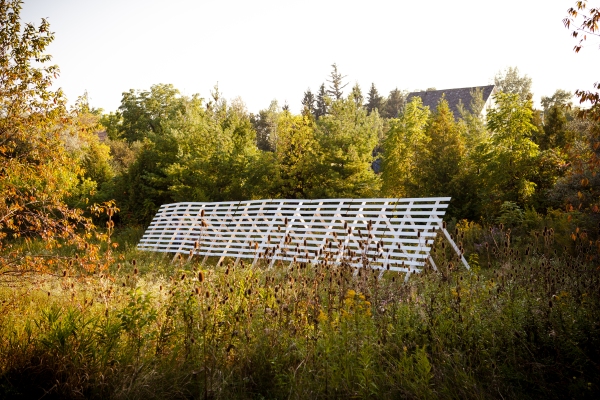
A line is one of the most basic elements of intent and organization with respect to our built environment. From the simplest lines come the various paths, boundaries and demarcations that have been inscribed, traversed, contested and defended. Borders, roads, fences, pipelines, greenbelts and flight paths are drawn and multiplied from map to territory and back again, representing our ideals, hopes, fears, and failures. As we continue to drift further afield, accumulating in certain spots and spreading out in others, we might begin to think about how and where we draw the line.Please note this installation is only viewable on Thursday, Friday, and Saturday nights. A companion piece to this project is located behind the Sawmill. The Line is produced with the support of the Canada Council for the Arts. located behind the Sawmill. The Line is produced with the support of the Canada Council for the Arts.
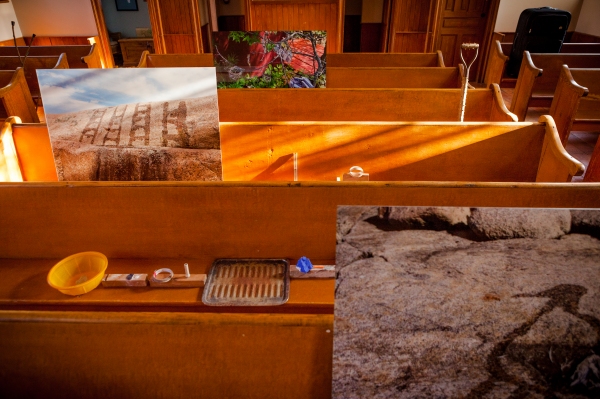
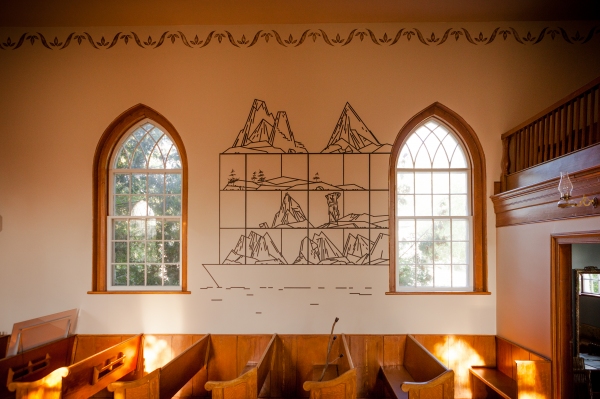
Many of the key idioms used in our civilization like society, environment, culture, growth, even happiness, require constant conceptual maintenance, because their meaning migrates, changes all the time. Some of these terms have died, despite the fact that we still use them, because the underlying meaning is no longer valid as a normative or descriptive tool, and realities which they are describing no longer exist. An inscription on the central wall in an old Baptist church, which hosts Morning Daily is calling, with sweet confidence: Come Ye Apart And Rest a While. So let's take a rest. Let's rest a while from our pre-conditions, habits, cruel lack of imagination in general, our way of being and doing. The point is to find a new approach, to avoid the error Albert Einstein warned us against, the one of trying to solve problems with the same way of thinking that created them. How hard is it to find a new way to think?

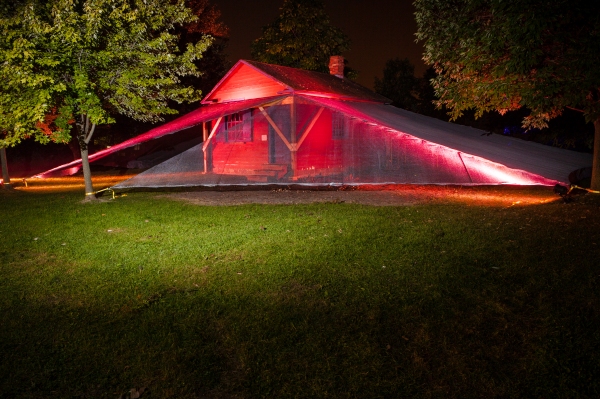
Levelling of land is one of the first acts of colonialism and settlement. Through this process of cut and fill the fertile soil is damaged as it is moved, stockpiled, and backfilled. This structure approximates the volume of soil displaced to redevelop the land on which the Wyper Harness shop originally stood. Its surface provides a space to rest and relax on in the museum grounds, allowing visitors a vantage point from which to watch the exhibition.

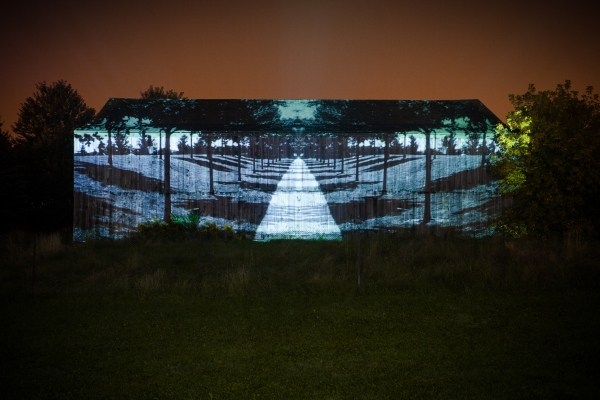
A line is one of the most basic elements of intent and organization with respect to our built environment. From the simplest lines come the various paths, boundaries and demarcations that have been inscribed, traversed, contested and defended. Borders, roads, fences, pipelines, greenbelts and flight paths are drawn and multiplied from map to territory and back again, representing our ideals, hopes, fears, and failures. As we continue to drift further afield, accumulating in certain spots and spreading out in others, we might begin to think about how and where we draw the line.Please note this installation is only viewable on Thursday, Friday, and Saturday nights. A companion piece to this project is located behind the Sawmill. The Line is produced with the support of the Canada Council for the Arts.
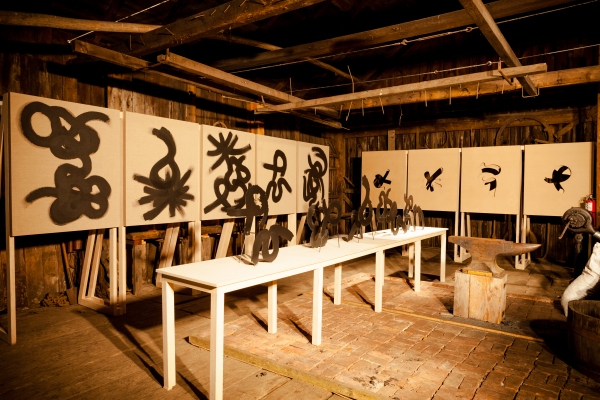
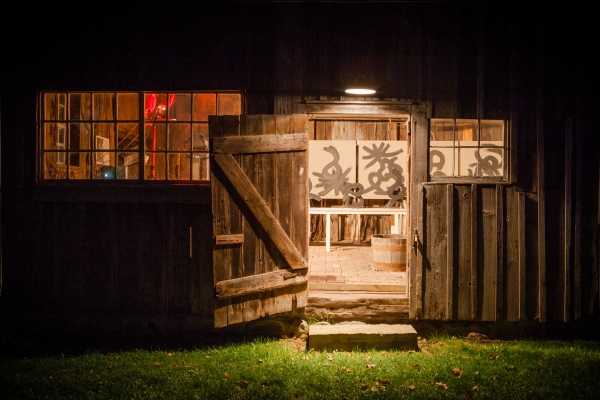
Strike While the Iron is Hot consists of a formal and spatial intervention. Marman and Borins engage in a process-oriented installation that utilizes painting, sculpture, and architectural expression. Influenced by the normative elements of pre-industrial revolution fabrication, yet with a focus on the attempt to standardize within a functional craft, the artists see the blacksmith shop as an entry point into an investigation of form that dictates a set of precepts. Consequently, they engage in gesture painting - but with restrictions, in the sculptural act of blacksmithing, but with preset patterns as their guide. They place upon themselves an imagined set of actions that metaphorically relate to the idea of fabricating originals within the context of repetitive forms intended for utilitarian purposes.
Videos
